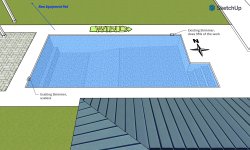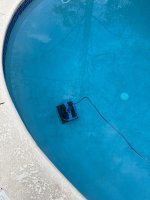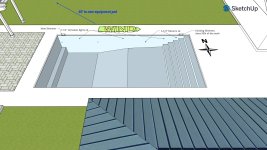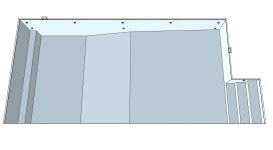My 33,000 gallon 20x40 in ground that was built in 1973 and fiberglassed in 1995 is getting an overhaul. We are doing architectural work that requires removal of the pool decking as well as relocating the pool equipment pad. The pool leaks heavily at the tile line, the fiberglass is blistering and delaminating, and we would like a plaster finish so there is an opportunity to substantially renovate the pool. Demolition crews will remove the concrete decking and fiberglass in the coming weeks. Then foundation preparations will take place and eventually trenching for a new garage and pool house construction project. While construction is taking place, I would like to upgrade the pool as follows:
Our existing Intelliflo VSF pump will be feeding a 48 square foot DE filter (possibly a new one, size and brand recommendations are welcome). Planning to install a bypass valve across our existing 250k btu Hayward heater since we only use it a couple times a year. The new equipment pad is going to be approximately 40' as the crow flies off the North West Corner of the pool. While I've been happy with liquid chlorine injection on our super stable fiberglass pool, plaster will change the chemistry substantially enough I am open to alternatives.
If this topic is overly general I am happy to manage it as a number of individual threads instead.
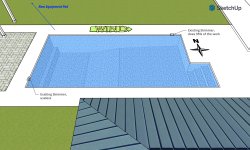
- Decommission existing in ground spa
- Possibly fill in the steps and put new ones in the shallow end somewhere (existing steps are encroaching on valuable pathway at the main house)
- Decommission the main drain (temporarily plugging it also slowed existing leakage)
- Replace or move the West Skimmer that only effectively skims a few days out of the year due to prevailing winds (best brand and features to look out for?)
- Replace or move the East Skimmer to the East Wall to better capture prevailing breeze
- Home run both skimmers to new equipment pad for energy efficiency and flexibility (preferred valve size, layout and brands?)
- Move and home run the returns to better sweep the steps at both ends (brand and size recommendations?)
- Install automated pool filler (float valve well or timed fill?)
- Install lighting along North wall (my family wants rgb lighting I prefer white, any brand/system recommendations?)
- Chip and plaster (architecture supports darker pool to support surface reflections; given how huge this topic is I'll handle it separately)
Our existing Intelliflo VSF pump will be feeding a 48 square foot DE filter (possibly a new one, size and brand recommendations are welcome). Planning to install a bypass valve across our existing 250k btu Hayward heater since we only use it a couple times a year. The new equipment pad is going to be approximately 40' as the crow flies off the North West Corner of the pool. While I've been happy with liquid chlorine injection on our super stable fiberglass pool, plaster will change the chemistry substantially enough I am open to alternatives.
If this topic is overly general I am happy to manage it as a number of individual threads instead.

Attachments
Last edited:


